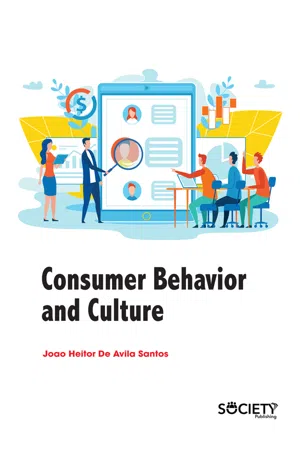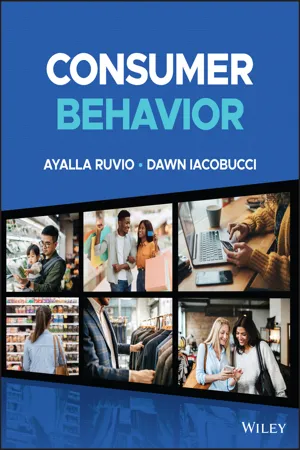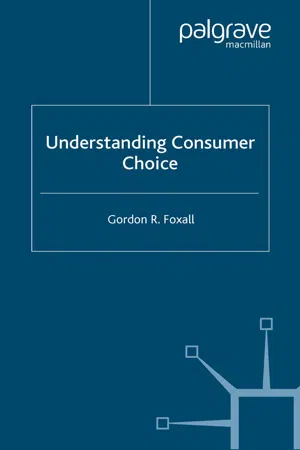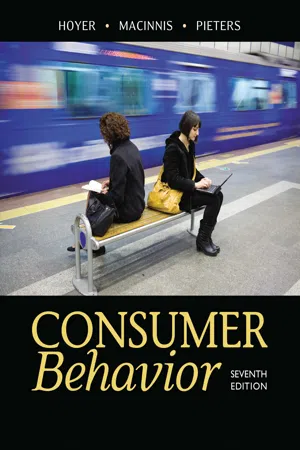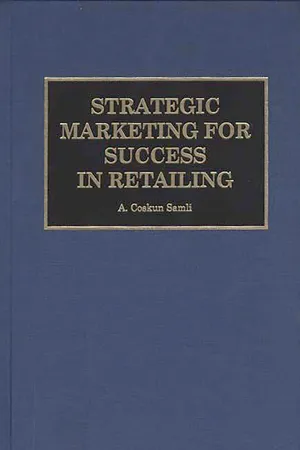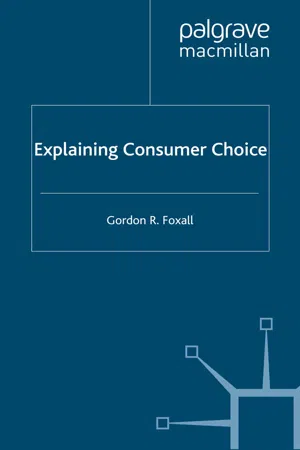Marketing
Consumer Behavior
Consumer behavior refers to the study of how individuals make decisions to spend their available resources on consumption-related items. It involves understanding the factors that influence consumers' purchasing decisions, such as psychological, social, and cultural influences. Marketers use this knowledge to develop strategies that effectively target and appeal to consumer preferences and behaviors.
Written by Perlego with AI-assistance
Related key terms
1 of 5
10 Key excerpts on "Consumer Behavior"
- eBook - PDF
- Joao Heitor De Avila Santos(Author)
- 2020(Publication Date)
- Society Publishing(Publisher)
If put in simple words, the study of Consumer Behavior focuses on the manner, in which the people make their decisions for spending the resources such as time, money, and efforts, which are available to them on the products which are regularly consumed by them. According to the definition proposed by the American Marketing Association (AMA), Consumer Behavior may be defined as: “The dynamic interaction of cognition, behavior, and environmental events by which human beings conduct the exchange aspect of their lives.” Consumer Behavior may also be defined as: “ The study of individuals, groups, or organizations and the processes they use to select, secure, use, and dispose of products, services, experiences, Consumer Behavior and Culture 14 or ideas to satisfy needs and the impacts that these processes have on the consumer and society.” The behavior of the consumer may take place in regard to one person or also may be in regard with a group of people, such as, the impact that a friend may have on the type of clothes that another friend may wear. It may also be there with regard to an organization. This may be seen in instances where the people in an organization take call on the firm whose services they want to subscribe to (Figure 1.5). Figure 1.5: Consumer Behavior is a very dynamic phenomenon and is extreme-ly vulnerable to change. Source: Image by Needpix. The use of the product is, in most cases of great use to the person marketing the product. This may have an impact on the way a product is positioned in the market and the steps that can be taken to promote more consumption of that product by the people. Consumer Behavior not only involves various service and ideas, but also takes into account the tangible products. The influence that the behavior of Introduction to Consumer Behavior 15 the consumers is on society is also quite relevant to the context. - eBook - ePub
- Paul Reynolds, Geoff Lancaster(Authors)
- 2005(Publication Date)
- Routledge(Publisher)
Buying Behaviour
DOI: 10.4324/9780080455020-44.1 Introduction
As consumers, we are continually exposed to different experiences and influences. Some of us are more susceptible to change and influences than others, but nobody goes through life remaining the same as they were at birth. Some of our responses to the environment are because of our psychological makeup. As our situations change, opportunities emerge as we become subject to a wider range of influences to which we might respond in a positive or negative manner. Changes in circumstances may arouse innate needs or promote new needs and wants in our consumption patterns.The job of marketing is to identify needs and wants accurately and develop products and services that will satisfy them. The role of marketing should not be to ‘create’ wants, but to fulfil them. Chapter 1 , which discussed the marketing concept, provided some explanation of what this means in terms of business practice.It is not sufficient to simply discover what customers require. It is more valuable to find out why it is required. Only by gaining a comprehensive understanding of buyer behaviour can marketing’s goals be realised. This understanding works to the advantage of both the consumer and marketer, because marketing becomes better equipped to satisfy customer needs efficiently. This should enable a company to establish a loyal group of customers with positive attitudes towards its products.4.2 Definitions
Consumer behaviour can be defined as:The acts of individuals directly involved in obtaining and using economic goods and services, including the decision processes that precede and determine these acts.The underlying concepts we now discuss form a system in which individual consumers are the core surrounded by an immediate and wider environment that influences their goals. Such goals are satisfied by consumers passing through a number of problem-solving stages that lead to purchasing decisions. - eBook - PDF
- Ayalla Ruvio, Dawn Iacobucci(Authors)
- 2023(Publication Date)
- Wiley(Publisher)
Likewise, the purchasing department can pay for software that will be used by each worker in the company. Consumer Behavior refers to how buyers (individuals, groups, or organizations) make deci- sions prior to, during, and after acquiring a product (goods, services, experiences, etc.) to satisfy their needs, wants, and demands. It encompasses all of the cognitive and psychological processes, behaviors, motivations, beliefs, emotions, and values that are associated with the acquisition, use, Consumer Behavior refers to how buyers (individuals, groups, or organizations) make decisions prior to, during, and after acquiring a product (goods, services, experiences, etc.) to satisfy their needs, wants, and demands. LEARNING OBJECTIVES After studying this chapter, you should be able to: • Understand why learning about Consumer Behavior is key to an organi- zation’s survival, growth, and success. • Understand that Consumer Behavior is important to anyone in business but especially to marketers. • Appreciate how marketers can help organizations meet consumers’ needs, wants, and demands. • Understand why consumers’ behavior is so challenging. 3 Consumer Behavior as a Multifaceted Phenomenon and disposal of products. 1 Acquisition of a product can occur in multiple ways – through pur- chasing, renting, sharing, borrowing, trading, and/or gifting – and all of these behaviors interest markets. Understanding Consumer Behavior is critical to any company or organization, regardless of size, type, or industry and whether they are nonprofit or for-profit, because the organization’s survival, growth, and success are built on its customers. The knowledge derived by studying con- sumers’ behavior is called consumer insights. - eBook - PDF
- G. Foxall(Author)
- 2005(Publication Date)
- Palgrave Macmillan(Publisher)
2 Consumer Behavior Consumer Behavior includes all of the activities of buyers, ex-buyers and potential buyers from prepurchase deliberation to postpurchase evaluation, and from continued consumption to discontinuance. It extends from the awareness of a want, through the search for and evaluation of possible means of satisfying it, and the act of purchase itself, to the evaluation of the purchased item in use, which directly impacts upon the probability of repur- chase (Alba et al., 1991). The models of Consumer Behavior that emerged in the mid- to late-1960s on which the central theoretical perspective for academic consumer research has since relied almost exclusively, provided a distinctive meld of cognitive and social psychologies. Fundamental com- ponents of this paradigm include the goal-oriented reception, encoding, representation and processes of information; but equally determining was the way in which this cognitive procedure was linked to behavior in the sequence of belief–, attitude–, and intention–formation. The initial empha- sis was upon high involvement processing but, by successive elaborations, several of the models have gradually acceded to and accommodated low involvement processing (Engel et al., 1995; Howard, 1989) which may influence capacity for recall without requiring prior evaluation (Hawkins & Hoch, 1992). An outline of Consumer Behavior Consumer Behavior is most frequently modeled as a cognitive process, an intellectual sequence of thinking, evaluating, and deciding. These informa- tion processing activities are believed to shape the more overt aspects of choice: acquiring information, perhaps from an advertisement or sales- person, placing an order, using the product selected, and so on. The inputs to the process are the most basic bits of data available to the consumer, stimuli from the environment in the form of marketing messages and con- versations with friends and relatives. - eBook - PDF
- Wayne Hoyer, Deborah J. MacInnis, Rik Pieters, , Wayne Hoyer, Deborah J. MacInnis, Rik Pieters(Authors)
- 2017(Publication Date)
- Cengage Learning EMEA(Publisher)
Copyright 2018 Cengage Learning. All Rights Reserved. May not be copied, scanned, or duplicated, in whole or in part. WCN 02-200-202 P ART ONE P P | A N I NTROD UC TION TO CONS U MER BEHAVIOR 16 1-3e CONSUMERS AND SOCIETY Understanding Consumer Behavior enables marketers and other organizations to provide tools for more informed decision-making. For example, research indicates that we better understand the differences among brands when we can view a chart, matrix, or grid comparing brands and their attributes. 81 Thus, matrices such as those presented in the Consumer Reports magazine or on its website are likely to help many consumers make better decisions. Product, service, and communications developments to protect certain consumer segments have also grown out of understanding how consumers behave. Many people want to protect children against inappropriate advertising or guard themselves against invasion of privacy. Some companies have changed their marketing voluntarily, whereas others have waited until legislators, regulators, or advocacy groups forced them to make changes. Finally, a better understand- ing of Consumer Behavior can pave the way for programs that benefit society. As discussed in Chapter 17, research on disposition behavior has the potential to aid recycling pro- grams and other environmental activities, just as research on charitable donations can help nonprofit groups design com- munications to attract and inform contributors. 1-4 Making Business Decisions Based on the Marketing Implications of Consumer Behavior As you learn about Consumer Behavior, you may wonder how businesses use different Consumer Behavior insights. Starting with Chapter 2, you will find numerous sections titled Marketing Implications that illustrate how marketers apply Consumer Behavior concepts in the real world. - eBook - PDF
- Pauline Maclaran, Michael Saren, Barbara Stern, Mark Tadajewski, Pauline Maclaran, Michael Saren, Barbara Stern, Mark Tadajewski(Authors)
- 2009(Publication Date)
- SAGE Publications Ltd(Publisher)
Consumer Behavior Analysis G o r d o n R . F o x a l l 17 INTRODUCTION Consumer psychology is usually cognitive in orientation. Scores of Consumer Behavior texts assume this theoretical position without considering the philosophical implications of the concepts on which they rely to explain choice, let alone offering any philosophical justification for the cognitive stance itself. It is rare for the writers of these texts, as it is for consumer psychologists generally, to consider that an alternative paradigm, behavior analy-sis, can assist in the explanation of consumer choice (Foxall, 2003). Yet, there is a large volume of evidence to show that economic behavior is reliably sensitive to environmental contingencies. Specifically, the subdiscipline of behavioral economics is concerned with the combination of experimental economics and operant psychology to elucidate economic relationships. Much of the work in behavioral economics has been concerned with nonhu-man animals, though there is an increasing tendency to apply the methods developed in the operant chamber to a wide range of applied human problems. Consumer Behavior analysis is the application of behavioral eco-nomics to the sphere of human consumer choice, particularly in the context of advanced marketing-oriented economies (Foxall, 2002). Now, marketing brings a further level of com-plexity to what is already a multi-disciplinary exercise. There are considerations stemming from human marketing activity that are never encountered in the laboratory regardless of whether the subjects are human or nonhuman. The very concept of exchange, for instance, is either nonexistent in the nonmarketing environment or very much less complicated. - eBook - PDF
- Louis Boone, , David Kurtz, , Louis Boone, David Kurtz(Authors)
- 2018(Publication Date)
- Cengage Learning EMEA(Publisher)
CHAPTER 6 Consumer Behavior CHAPTER 7 Business Markets and Buying Behavior CHAPTER 8 Global Marketing UNDERSTANDING BUYERS AND MARKETS 2 Copyright 2019 Cengage Learning. All Rights Reserved. May not be copied, scanned, or duplicated, in whole or in part. Due to electronic rights, some third party content may be suppressed from the eBook and/or eChapter(s). Editorial review has deemed that any suppressed content does not materially affect the overall learning experience. Cengage Learning reserves the right to remove additional content at any time if subsequent rights restrictions require it. 6.1 Identify the three types of influences that affect the consumer decision process. 6.2 Outline the six steps in the consumer decision process. 6.3 Distinguish between high-involvement and low-involvement purchase decisions. 6.4 Describe the five social factors that influence Consumer Behavior. 6.5 Describe the five psychological factors that influence Consumer Behavior. 6.6 Describe the four situational factors that influence Consumer Behavior. 6.7 Given a consumer purchase scenario, identify the primary influences affecting the consumer decision process. LEARNING OBJECTIVES Consumer Behavior 6 Source: www.skibutternut.com Copyright 2019 Cengage Learning. All Rights Reserved. May not be copied, scanned, or duplicated, in whole or in part. Due to electronic rights, some third party content may be suppressed from the eBook and/or eChapter(s). Editorial review has deemed that any suppressed content does not materially affect the overall learning experience. Cengage Learning reserves the right to remove additional content at any time if subsequent rights restrictions require it. OPENING EXAMPLE Grocery shopping is where the rubber meets the road for consumer packaged goods companies. Success hinges on consumers selecting their products and placing them in the grocery cart for purchase. - eBook - PDF
- A. Coskun Samli(Author)
- 1998(Publication Date)
- Praeger(Publisher)
Purchase-behavior-related theory and information must be systematically organized so that retailers can better serve their customers and enhance their market position and profit picture. Exhibit 7.1 illustrates a general Consumer Behavior model that is appropriate for retailing. Retail Consumer Behavior is functionally related to seven components: (1) cultural background, (2) individual personality, (3) need realization and shopping motivation, (4) shopper characteris- tics, (5) purchase behavior, (6) store choice, brand choice, and product choice behaviors, and (7) buyer remorse or cognitive dissonance. Component five of Exhibit 7.1 illustrates and discusses the specific aspects of the Consumer Behavior model pertinent to retailing. This discussion is particularly important to retailers, since it brings con- sumer behavior theory and retailing practices together. The main thrust of this model is to distinguish shopping motivation from shopper char- acteristics and connect them to marketing functions by the retailer. The retailer must take into account the behavior in its target markets and influence this behavior by proactive management practices. It is critical to assume that motivation can be conditioned by external stimuli, whereas shopper characteristics are innate. For instance, agree- able shoppers who are brand loyal and cautious cannot suddenly be- come status shoppers who are impractical, go for new gadgets, and are impulse buyers. These shopper characteristics can further modify shop- ping motivation. It is critical to understand them and work with them. Both internal and external influences must be identified carefully and dealt with effectively. They are discussed in some detail later on 126 Strategic Marketing for Success in Retailing in this chapter. Obviously, all external influences in internal modifi- ers form the consumers' purchase process. - eBook - PDF
Applied Marketing
Connecting Classrooms to Careers
- Daniel Padgett, Andrew Loos(Authors)
- 2019(Publication Date)
- Wiley(Publisher)
We will cover this in more detail in Chapter 6. Suffice it to say for now that for practical purposes we can think of individuals and companies in the same way from a marketing perspective. Mar- keters still have to understand how and why each type of customer does things in a particular way and then determine how to influence the experience to maximize perceived value. 70 CHAPTER 4 Customer Behavior 4.3 Concept Check 1. What factors make business buyers different from individual consumers? 2. Describe the different roles in a buying center. Chapter Summary 4.1 General Model of Customer Experience • When companies say they want to provide a superior customer experience, in simple terms they mean they want customers’ thoughts, feelings, and behaviors associated with a purchase to be positive or very positive. To be more specific, the customer experience includes the customer’s thoughts, feelings, and behaviors before, during, and after an exchange. • The general model of customer experience includes five steps and can be applied to any exchange, whether the exchange is complex or simple. • The beginning step of any exchange (purchase) is recognition of a need. • Once a need is recognized, the customer will search for options that will satisfy the need, and the search will be dependent on how the customer wants to satisfy the need (translates the spe- cific need into a want). • Once the customer has the information needed to make a deci- sion, the next step is to evaluate the alternatives so that a choice can be made. Customers evaluate alternatives by assessing the relative perceived value of one alternative to another. • Once the customer has evaluated the options, the customer makes a choice and has to make the purchase to complete the exchange. • After making a purchase, the customer typically uses (consumes) the product. Using the product provides an opportunity for the customer to evaluate the purchase to determine if the need was actually satisfied. - eBook - PDF
- G. Foxall(Author)
- 2007(Publication Date)
- Palgrave Macmillan(Publisher)
The resulting research program initially took the form of a critique of the conventional wisdom by which Consumer Behavior was explained in the context of marketing study, indicating for instance how notions 6 Explaining Consumer Choice of attitudinal – behavioral consistency, generally and somewhat uncrit- ically accepted within that realm, might be subjected to critical exam- ination and supplemented or replaced by alternative explanations (Foxall, 1983). This process was subsequently extended to areas of research such as consumer innovativeness (Foxall, 1987), and the program entered a fruitful phase with the development of the Behavioral Perspective Model (BPM) of consumer choice (Foxall, 1990/2004) which permitted the behavioral interpretation of purchase and consumption, saving and domestic financial management, innov- ative consumer choice, “green” Consumer Behavior, and of marketing management (Foxall, 1994a, b, 1995, 1996, 1998). This model also led to the first empirical research in Consumer Behavior analysis, a contin- uing project which is concerned with the prediction of consumers’ verbal behavior with respect to their emotional reactions to environ- ments of purchase and consumption (Foxall, 1995, 1997a, 1999; Foxall and Greenley, 1998, 1999, 2000; Foxall and Yani-de-Soriano, 2005; Soriano and Foxall, 2001, 2002; Yani-de-Soriano and Foxall, 2006). Further empirical work has been concerned with the extent to which the methodology of behavioral economics can be employed to eluci- date patterns of consumer choice (Foxall and James, 2001, 2003; Foxall and Schrezenmaier, 2003; Foxall, Oliveira-Castro and Schrezenmaier, 2004; Oliveira-Castro, Foxall and Schrezenmaier, 2004, 2005, 2006). It has also proved possible to extend the interpretation of Consumer Behavior through the employment of the model (Foxall, James, Oliveira-Castro and Chang, 2006), and to develop the theoretical and philosophical bases of the research program.
Index pages curate the most relevant extracts from our library of academic textbooks. They’ve been created using an in-house natural language model (NLM), each adding context and meaning to key research topics.
